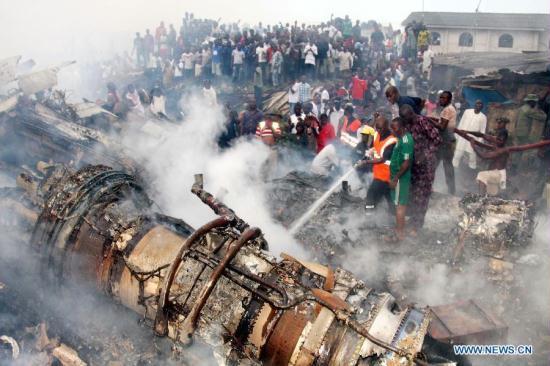
Over the years, aviation stakeholders, particularly sundry experts, have tried to ensure that victims of air accident in Nigeria are responded to rapidly to enhance the survival rate.
Despite these efforts, there are still complaints that the responds time to air emergencies in the country is not encouraging; hence at the end of every attempt at rescuing victims of air disasters, nothing is achieved.
For example, when the ill-fated Bellview airlines’ plane crashed October 25, 2005 at Lisa Village in Ogun state, it took several hours before Search and Rescue (SAR) team and the National Emergency Management Agency (NEMA) and others bodies saddled with the job of or aviation emergencies arrived the scene of the accident. Even residents of the local communities who should have been at the scene soon after the accident occurred, ahead of the SAR and NEMA teams, did not know what to do. Also, even if they would have loved to get to the scene to rescue the victims, the fear of security agents who could harass, or even harm them. Eventually, the entire 117 passengers on board died.
Also, on March 15, 2008, a twin-turbo prop 19-seater aircraft belonging to Wings Aviation crashed in Calabar while on a routine flight from the Murtala Muhammed Airport (MMA), Lagos. It took several days for the hunters in communities closer to the crash site to find the carcass of the aircraft and the remains of the victims.
Also, when Dana Air’s MD83 airplane flight 992 crashed on June 3, last year in Iju–Ishaga, the rescue team did not get there on time despite the fact that the aircraft crashed into a residential area. The local communities, rather than trying to rescue victims of the crash, unfortunately watched the victims die. The crowd on the roads leading to the street where the plane crashed, and at the crash site did not help matters as they became a nuisance to genuine rescue activities. The access roads to the crash site were blocked by mostly onlookers, or those who did not have any business being there.
At the end about 160 people aboard the plane and on ground died.
On the other hand, local communities in and around air crash sites oftentimes do not know what to do in the case of emergency, even when they have access to the accident sites.
Lack of training
Aviation stakeholders often argued that the local communities should not be blamed for not helping during air emergencies, because they are not trained to do so, or even given necessary orientation that would enable them even provide information that can help the appropriate agencies. They also argue that there is no way the local communities would join in air accident emergencies when the various agencies concerned with this responsibility are themselves not coordinated.
Oftentimes unfortunately also, according to various respondents, these agencies rather than remain focus for proper coordination of the rescue activities unnecessarily biker over such mundane issues as which of the agency should lead the entire efforts.
Only recent a Boeing aircraft 737-800 series belonging to Lion Air, Indonesia’s largest airline crashed into a river just off the runway of the main airport on the country’s resort island of Bali. All 101 passengers and seven crew members on the flight, which originated from the city of Bandung, were rescued as the aircraft was evacuated after crashing. The feat was achieved because the rescuers responded to the air emergency on time compared to Nigeria where response time usually takes hours.
It was based on the need to ensure that victims of air crashes are rescued on time as done in other countries of the world, and to minimise the casualty rate at such times, that a stakeholders meeting on the matter was convened recently.
Stakeholders speak
The meeting under the auspices of the Airport Emergency Planning Committee was organised to discuss the need to train local communities on air accident emergency and to integrate them into Search and Rescue (SAR).
Speaking at the forum held at the Murtala Muhammed International Airport (MMIA), Lagos, the Chairman, Airport Emergency Planning Committee, Edward Olarerin, said communities around the airport would not only be trained on air emergencies, but be integrated into SARS, National Emergency Management Agency (NEMA) and other bodies that have roles to play in either air emergency or aviation.
He assured that all government agencies at the airport, including the National Emergency Management Agency (NEMA) would partner with the communities in training them for any air emergency situation.
According to him, “we have contacted the local governments around the airport to give us some people that we will train along with our search and rescue operatives. This people will now go back to their communities to enlighten their peers about search and rescue during an air emergency,”
He announced that the Federal Airport Authority of Nigeria (FAAN) and the Nigerian Airspace Management Agency (NAMA) would organised a mandatory two years drill for officials of both agencies.
Speaking at the stakeholders forum, Principal Planning Officer, NEMA, Babatunde Olowokere, said the training of people at the grassroots level is not new to the agency, as it has been training local communities at various local government Areas in the country.
He argued that response to disaster and management should not be left for one agency, and that it should rather be a collective responsibility, if the target goal must be achieved.
According to him, training of grass people “is a continuous exercise, in the sense that we have a goal that disaster is everybody’s business and the more people know what to do during disaster the better for life saving. And it also makes our work easier in the sense that if you give then requisite knowledge and skill on how to manage disaster when it happens, they will be able to do that before because disaster normally happens at a particular place that is the grass root.”
The NEMA official added that if the local communities are trained and equipped on what to do in the event of an air accident, they would know what to do before NEMA and other agencies get to the site of the crash.
He particularly mentioned Ifako-Ijaye, Local Government Areas, as one of the local governments where local communities needed to be trained and equipped on air accident emergences, since according to him, that is the route that aircrafts take.
“If we train them and equipment them on what to do before we even get there they would have started doing something in making sure that lives are not loss and that is what we have been doing. More so, particularly these local government Ifako-Ijaye, we know that, that is the route that the plane takes, we want to carry out advocacy on what you do when there is a crash and also to train them on how to carry out search and rescue operation especially in giving first aids to victims that are trapped, that is the training” he said.
He promised that the agency will carry out advocacy on what you do when there is air crash, adding that NEMA is also training local communities on how to carry out Search and Rescue (SAR) operations especially in the area of administering first aid to trapped victims.
Challenge
Olowokere also pointed out that one of the major challenges faced by the agency was that most of the local government areas in the country are reluctant to collaborate with the agency on disaster.
“The challenge we have is the corporation from the local government, if they are willing to collaborate with us, our job will be simpler. Our men have been trained to carry out such exercise” he said
Speaking on the equipment to carry out rescue operations, he said that all over the world organisations that manage disaster does not have all the equipment used in carrying out operations, adding that they sign a Memorandum of Understanding (MoU) with other organisations.
He added that in Nigeria it is not different, as NEMA already signed MoU with major construction companies such as Julius Berger, Dantata and others, adding that whenever there is any disaster, these companies don’t wait until they are called they just go there because there is an existing MoU.
On his part, an aviation analyst, Mr Olumide Ohunayo, said that it is a good beginning as it is not only aimed at enhancing safety but also improving emergency response time.
Ohunayo, hoped that the training will also teach the local communities how not temper with aircraft parts at the site of the accident, adding that is unfair to attribute the inability of rescuers to get to the site of Dana crash on time led to the death of close to 160 people.
According to him, “I quite agree with the committee and look forward to the training and incorporation of those trained in the search and rescue team. It Is to enhance safety, improve emergency responsive time. It is unfair to link with Dana crash; I bet you Nigerians would have gone into that aircraft if there was any semblance of life. They were all dead because of the impact, coupled with internal and external smoke/fire that made it impossible to open the aircraft doors. I just hope the training will also educate them on the need not take anything away from crash site or touch aircraft parts seen at the vicinity of the crash”
An aeronautic engineer, Sheri Kyari, also agreed on the need to train local communities in air emergences, describing it as a step in the right direction, adding that it of the airport emergency plans.
He however, argued that finance to carry out the laudable programme could be a hindrance, urging the Airport Emergency Committee to ensure that the training programme is carried out in collaboration with NEMA so as to tap from its wealth of experience and facilities on emergency response and management.
The President of Aviation Round Table (ART) and former Nigeria Airways Limited (NAL) Pilot, Capt Dele Ore agreed that the committee should ensure training of local communities at local government levels so that when there is air emergency, they know what to do.
According to him, “we are beginning to get to the real issue that has to do with air accidents. They should continue to strive and should not rest on their oars. It is a good step in the right direction.”
He also called for a sensitisation programme for people in the airport environment, where staff of agencies at the airport will be taught on what to do when there is air emergency.
Friday 26 April 2013
http://dailyindependentnig.com/2013/04/training-local-communities-for-air-disaster-rescue-operations/







